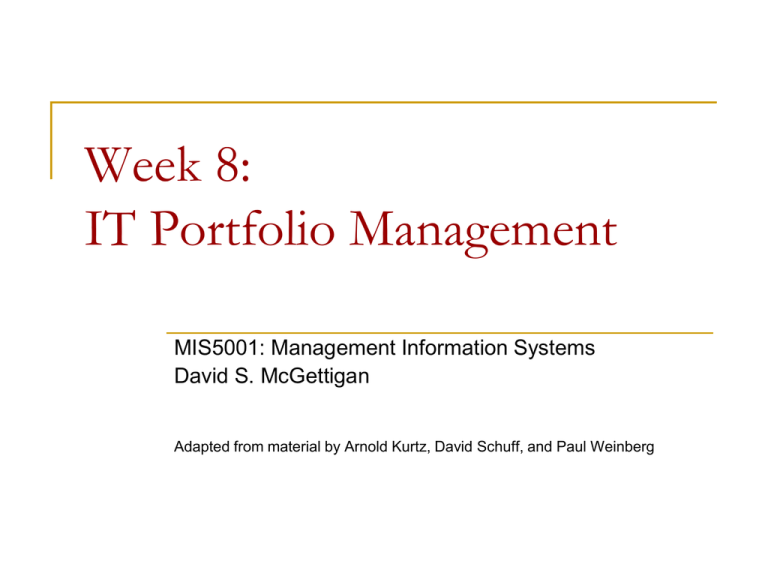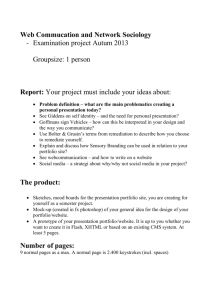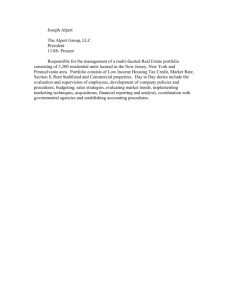Week 8 – IT Portfolio Management
advertisement

Week 8: IT Portfolio Management MIS5001: Management Information Systems David S. McGettigan Adapted from material by Arnold Kurtz, David Schuff, and Paul Weinberg Agenda Prior Lecture Recap Capturing the Business Value of Systems IT Portfolio Management Next Week 2 Prior Lecture Recap Prior Lecture Recap Customer Relationship Management Business Intelligence Brings together information regarding customers, sales, marketing, and products Functions supported and management issues Knowledge about your customers, competitors, partners, competitive environment, and internal operations Enables users to identify and understand the key trends and events driving their businesses Uses and challenges Knowledge Management Knowledge management comprises a range of strategies and practices used in an organization to identify, create, represent, distribute, and enable adoption of insights and experiences. Benefits, Communities of Practice, Communities of Interest 4 Capturing the Business Value of Systems NOTE: This section is a primer for IT Portfolio Management which follows Capital Budgeting Capital budgeting is the process of analyzing and selecting various proposals for capital expenditures. Information systems are considered long-term capital investment projects. Types of investments: Meeting demand / enhancing profitability Meeting or enhancing compliance (Quality, Regulatory, SARBOX, etc) 6 Cost/Benefit Analysis Costs: Hardware Software Services Personnel Benefits: Tangible (“Hard”) Intangible (“Soft”) 7 Costs and Benefits of IT Solutions Challenge: capturing total costs Challenge: quantifying benefits 8 Budgeting Models Capital budgeting models are used to evaluate capital projects (and hence understand the value of IT projects) The payback method The accounting rate of return on investment (ROI) The net present value 9 Payback Method The payback method is quite simple: It is a measure of the time required to pay back the initial investment of a project. The payback period is computed as follows: The method ignores the time value of money, the amount of cash flow after the payback period, the disposal value (usually zero with computer systems), and the profitability of the investment. 10 ROI Return on Investment Use the present value of net benefits Compare to cost of capital and/or other projects Expressed as a percentage 11 NPV Net Present Value The amount of money an investment is worth, taking into account its cost, earnings, and the time value of money. Expressed in dollars. Capturing financial benefits can be straightforward, but what costs should be included in the analysis? 12 Problems with Managing by Capital Budgets - TOC Consider acquisition costs and maintenance costs The cost of “owning” a PC (or a server) can be several times more per year than the original purchase cost Examples of maintenance costs Repair contracts Configuration management Downtime and lost productivity Upgrades 13 Problems with Managing by Capital Budgets - Intangibles How to quantify the intangible benefits Frequently includes “musts” e.g. Quality and Regulatory These intangibles prevent the capital budgeting process from being the sole effective portfolio management technique 14 IT Portfolio Management Honor isn't about making the right choices. It's about dealing with the consequences. Midori Koto Business Drivers Drivers for IT Portfolio Management: Complexity Cost Cross-functional Relationships with other programs Volume 16 Definition Portfolio management - a methodology for presenting a holistic view of IT projects across the enterprise in order to ensure alignment of IT with corporate strategy Source: www.cio.com 17 Portfolio Management SEVENTY-FIVE PERCENT of companies do not possess clear, ongoing oversight of their IT project portfolios. - AMR Research study. Funding Optimal mix of risk and reward Better communication Strengthened alignment between IS and the business. More efficient use of human resources Fewer redundant and overlapping projects Source: www.cio.com 18 Methodology Ensure projects appropriately linked and managed Conduct a project inventory Establish criteria aligned with corporate values and objectives Classify and evaluate programs Apply prioritization methodology Actively manage the portfolio 19 Prioritization CANCEL DEFER Cost DEFER EXECUTE Value 20 Portfolio Mgmt Exercise See class handout 21 Portfolio Classifications Infrastructure Transactional Process and automate the basic transactions of the company to reduce costs Informational Provides shared based of capabilities for the organization, leading to greater business flexibility Provide info to manage the company, resulting in shorter time to market or increased quality Strategic Usually higher risk and external facing systems result in sales growth or competitive advantage. Source: www.cio.com 22 Portfolio Comparison Agility Portfolio Infrastructure Informational Source: www.cio.com Transactional Strategic Cost-based Portfolio Infrastructure Informational Transactional Strategic 23 Case Study: Bound to Fail Describe the system in question (“SBS”) What was the supportability of the system in 1997 (beginning of the case)? What were the business conditions and “distractions” at the time? Describe IT planning at Comair (e.g. 5-year) What was the impact of the acquisition by Delta? CIO.com – Bound to Fail – May 1, 2005 24 Case Study: Bound to Fail How were the companies business processes reflected in the system? Describe the crash event. When did the crash take place? What was the root cause? What was the business impact? What was the immediate remediation plan in terms of personnel and systems? Brainstorm: How could this have been avoided? CIO.com – Bound to Fail – May 1, 2005 25 Case Study: Volkswagen What is your assessment of the new process for managing priorities at Volkswagen of America? Is it better or worse than the old process? Are the criticisms justified? How should Matulovic respond to his fellow executives who are calling to ask him for special treatment outside the new priority management system? Does Volkswagen need a new selection system? How is it possible that under this new system a “critical” project (global supply chain system) was unfunded? What should be done about that? 26 Next Week Enterprise Applications







